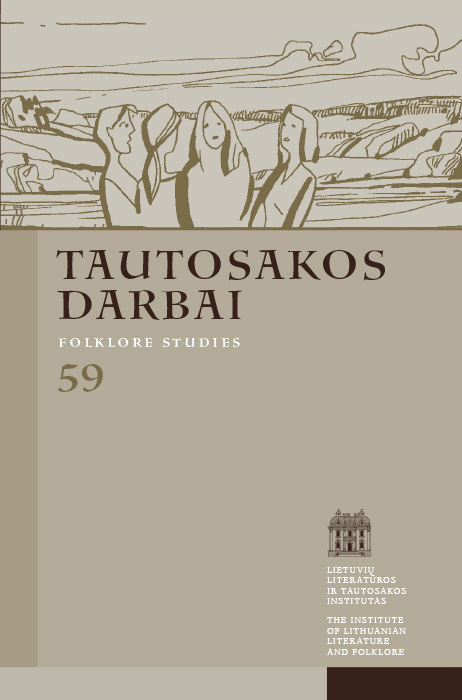Lietuvių talalinė: šiapus ir anapus leidžiamo juoko ribų
Santrauka
Straipsnis skirtas lietuvių folkloristikoje mažai tirtam periferiniam talalinės žanrui aptarti. Apžvelgiama jo rinkimo bei spausdinimo, taip pat tyrimo istorija XIX a. antrosios pusės–XX a. laikotarpiu, dėmesį labiau koncentruojant į prieškarį. Pagrindine pateikto tyrimo problema šalia kitų aktualių talalinių procesui akcentų pasirinktos jo komunikacinės intencijos, turint galvoje žanro populiarumą, nepaisant to, jog pusė tiriamos medžiagos yra obsceniško turinio ir necenzūrinės raiškos. Prieinama prie išvados, jog transgresija – peržengimas draudžiamos ribos, už kurios smagiai ir tarpo komiška nešvankioji kūryba, gali palankiai veikti, netgi telkti sociumą, iš anksto susitaikiusį su tam tikrais kompromisais. Analizės akiratyje ir lietuvių talalinei tradiciškai artima laikoma to paties laikotarpio rusų kupletų formos liaudies poezija (rus. чаcтушки) ir labai platus jai skirtas mokslinis diskursas. Talalinės tekstai ir kontekstai interpretuoti nuolat siekiantis hermeneutinės metodikos atramų; naudotasi spausdintais šaltiniais ir Lietuvių tautosakos archyve esančia medžiaga.
Atsisiuntimai
Skaitomiausi šio autoriaus(ų) straipsniai
- Bronė Stundžienė, Iš sovietinės dainotyros: tarp pasirinkimo ir prievolės , Tautosakos darbai: T 65 (2023): Tautosakos darbai
- Bronė Stundžienė, Apdainavimų naratyvas ir jo istorinės atminties kontekstai , Tautosakos darbai: T 63 (2022)
- Živilė Ramoškaitė, Bronė Stundžienė, Apžvelgiant dainotyros horizontus. Bronę Stundžienę kalbina Živilė Ramoškaitė , Tautosakos darbai: T 64 (2022)
- Bronė Stundžienė, Kraštovaizdžio raišką dainose apmąstant , Tautosakos darbai: T 47 (2014)
- Bronė Stundžienė, Dainų pašaukti: knyga apie vieno folklorinio ansamblio gyvenimą , Tautosakos darbai: T 57 (2019)
- Bronė Stundžienė, Šeimos naratyvas dainose: ritualo atodangos ir kintančių kontekstų reikšmė , Tautosakos darbai: T 51 (2016)
- Bronė Stundžienė, Laiko žymės Dainyno skelbimo istorijoje , Tautosakos darbai: T 61 (2021)
- Bronė Stundžienė, Įvietinta folklorinė atmintis grožinėje kūryboje: pasvalietiškoji versija , Tautosakos darbai: T 49 (2015)
- Bronė Stundžienė, Atsigręžiant į lietuvių liaudies dainų skelbimo ištakas , Tautosakos darbai: T 56 (2018)
- Bronė Stundžienė, Rita Černiauskienė, Gimnazistiškos vieno etnologinio tyrimo patirtys iš arčiau , Tautosakos darbai: T 57 (2019)
